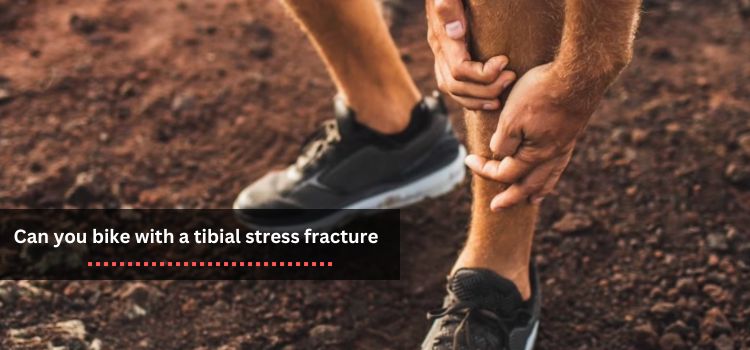A tibial pressure crack is a typical abuse injury that influences the shinbone, or tibia. It happens when dreary pressure or effect on the bone surpasses its capacity to fix itself, bringing about a little break or crack. While rest and legitimate treatment are fundamental for mending, numerous people keep thinking about whether they can keep trekking with a tibial pressure break. In this far-reaching guide, we’ll investigate the dangers, contemplations, and expected ramifications of trekking with a tibial pressure crack.

Understanding Tibial Pressure Cracks: Causes, Side Effects, and Treatment
Prior to digging into the subject of trekking with a tibial pressure break, understanding the idea of the injury itself is pivotal. Tibial pressure cracks commonly happen because of monotonous pressure or abuse, frequently found in competitors who take part in high-influence exercises like running or hopping. Nonetheless, they can likewise happen in people who take part in exercises that include dreary stacking of the lower leg, like cycling.
Normal side effects of a tibial pressure break incorporate torment, delicacy, and enlarging along the shinbone. The aggravation might deteriorate with action and improve with rest. Treatment normally includes rest, immobilization, and movement adjustment to permit the issue that remains to be worked out appropriately. At times, careful intercession might be vital, albeit most tibial pressure breaks can be overseen moderately.
Trekking with a Tibial Pressure Break: Dangers and Contemplations
Trekking, being a low-influence action, is in many cases considered a protected option for people recuperating from lower furthest-point wounds. Notwithstanding, trekking with a tibial pressure break presents one-of-a-kind dangers and contemplations that people ought to know about:
1. Increased Weight on the Tibia: While trekking is for the most part low-influence, it actually includes tedious movement and stacking of the lower limits. Contingent upon the seriousness and area of the pressure break, trekking may worsen the injury and postpone recuperating by putting extra weight on the tibia.
2. Risk of Complexities: Trekking with a tibial pressure break conveys the gamble of intricacies like demolishing the crack, deferring recuperating, or creating other abuse wounds. Proceeding with weight on the harmed bone can prompt removal of the break, nonunion (disappointment of the unresolved issue), or movement to a more extreme crack.
3. Pain Administration: Regardless of whether trekking doesn’t make further harm the tibia, it might fuel torment and distress related with the pressure break. People might find it trying to endure the aggravation while trekking, prompting diminished execution and pleasure in the action.
4. Impact of Bicycle Fit and Riding Position: The attack of the bicycle and riding position can likewise impact how much pressure put on the tibia. Unfortunate bicycle fit or ill-advised riding methods might increment burden on the lower furthest points, fueling the pressure crack and impeding the mending system.
5. Individual Contemplations: The choice to bicycle with a tibial pressure crack ought to be founded on individual factors like the seriousness of the injury, torment resilience, and direction from a medical care proficient. While certain people might have the option to endure trekking with a gentle pressure break, others might have to try not to cycle through and through until the crack has recuperated.
Elective Activity Choices During Recuperation
For people with a tibial pressure break who can’t bicycle or participate in weight-bearing exercises, there are elective activity choices that can assist with keeping up with cardiovascular wellness and muscle strength without worsening the injury:
1. Swimming or Water Heart stimulating exercise: Water-based exercises, for example, swimming or water heart-stimulating exercise give a low-influence exercise that diminishes weight on the lower furthest points while also giving cardiovascular advantages and reinforcing muscles.
2. Stationary Cycling: Utilizing an exercise bike or indoor cycling machine permits people to control the power and term of their exercise while limiting effect on the tibia. Changing the obstruction and rhythm can assist with fitting the exercise to individual requirements and solace levels.
3. Upper Body Activities: Spotlight on fortifying the chest area and center muscles through activities like paddling, arm ergometer (arm bicycle), or obstruction preparing. These activities assist with keeping up with generally speaking wellness and can be performed without putting weight on the lower furthest points.
4. Flexibility and Versatility Work: Integrate extending, yoga, or Pilates activities to further develop adaptability, portability, and joint scope of movement. These exercises assist with forestalling muscle snugness and firmness, which can happen during times of decreased movement or immobilization.
Discussion with a Medical services Proficient
Prior to endeavoring to bicycle or take part in any active work with a tibial pressure crack, it’s fundamental to talk with a medical service proficient, for example, a muscular specialist or sports medication doctor. They can evaluate the seriousness of the injury, give direction on fitting treatment and movement adjustment, and propose customized proposals in light of individual requirements and conditions.
Final Word
While trekking may appear to be a low-influence action reasonable for people with tibial pressure cracks, taking into account the likely dangers and implications is fundamental. Proceeding to bicycle with an untreated or deficiently recuperated pressure crack can deteriorate the injury, postpone recuperation, and lead to long-haul difficulties. Focusing on recuperating and recuperation by observing fitting treatment rules, changing exercises depending on the situation, and looking for direction from medical care experts is vital for guaranteeing a protected and fruitful re-visitation of trekking and other proactive tasks from here on out.
Regularly Clarified some pressing issues (FAQs) About Trekking with a Tibial Pressure Crack
1. Is it protected to bicycle with a tibial pressure crack?
– Trekking with a tibial pressure break presents dangers and contemplations. While trekking is for the most part low-influence, it actually includes tedious movement and stacking of the lower furthest points, which might compound the break. It’s fundamental to talk with a medical care proficient prior to endeavoring to bicycle with a tibial pressure break to decide whether it’s safe for your particular condition.
2. Can trekking deteriorate a tibial pressure break?
– Trekking can possibly deteriorate a tibial pressure crack by expanding weight on the harmed bone and postponing the recuperating system. Proceeding with the burden on the break site can prompt uprooting of the crack, nonunion, or movement to a more extreme break. Focusing on recuperating and recuperation by observing suitable treatment rules and movement modifications is urgent.
3. How could I at any point oversee torment while trekking with a tibial pressure break?
– Overseeing torment while trekking with a tibial pressure break might be trying because of the uneasiness related with the injury. Methodologies to oversee torment incorporate changing bicycle fit and riding position to limit weight on the tibia, utilizing steady footwear and orthotics, assuming control of over-the-counter agony drug as suggested by a medical service proficient, and decreasing force and span of trekking meetings on a case-by-case basis.
4. Are there elective activities I can do while recuperating from a tibial pressure break?
– Indeed, there are elective activities that people recuperating from a tibial pressure break can do to keep up with wellness and strength without intensifying the injury. Choices incorporate swimming or water high-impact exercise, fixed cycling, chest area activities, adaptability and versatility work, and low-influence exercises like strolling or curved preparing. Talk with a medical care proficient for customized proposals in view of your particular condition.
5. When could I at any point securely continue trekking after a tibial pressure break?
– The timing for securely continuing trekking after a tibial pressure crack relies upon the seriousness of the injury, individual recuperating rate, and direction from a medical service proficient. As a general rule, it’s essential to permit adequate time for the break to mend totally prior to getting back to trekking or other weight-bearing exercises. Slowly once again introduce trekking into your everyday practice under the management of a medical services proficient, and pay attention to your body’s signs to abstain from getting out of hand and taking a chance with re-injury.


